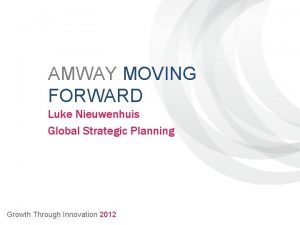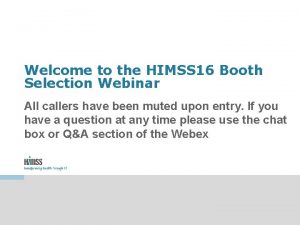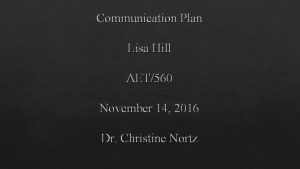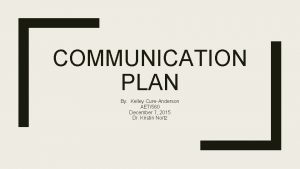COMMUNICATION PLAN Jennifer Pettit AET560 March 7 2016









- Slides: 9

COMMUNICATION PLAN Jennifer Pettit AET/560 March 7, 2016 Professor Christine Nortz

TABLE OF CONTENTS Slide 3 - How to launch the communication plan Slide 4 - The technology needed to accomplish the plan Slide 5 - How to test its effectiveness and the impact of management’s response to the organizational change Slide 6 - How to generate feedback for continuous improvement Slide 7 - How to address negative responses or communication about the change Slide 8 - How the communication plan can affect organizational change

HOW TO LAUNCH THE COMMUNICATION PLAN Pre-change Approval: Midstream Change: When addressing senior management, customer feedback, current technological trends and data points will be utilized to confirm the need for a change in how we interact with our customers on the sale floors. Quarterly surveys, focus groups, and company facilitated discussions will be used to monitor the impact of change at every level. Positive changes and set backs will both be addressed by leaders at each level. Creating Need: Through use video’s showcasing model “sells” and customer interactions on the floor, stakeholders will have a visual representation of change. Training department live feeds showcasing simulation assignments in progress. Visuals showcasing transformations in the story made to support the customer experience, disseminated to stakeholders through varying forms of communication. Initial phases of change involve seeking feedback from varying employees and customers about product knowledge. Data utilize to persuade senior management and feedback will be utilized to a convey need with the team. Confirming Change:

THE TECHNOLOGY NEEDED TO ACCOMPLISH THE PLAN § Initial communication will occur through use of live video streaming conference via the company website. § Infographics and Slide shares will communicate details in small chunks through the website. § Newsletters via email blast will be utilized by senior management when communicating with stakeholders. § Learning management system housing company platform for blogging and teleconferencing incorporated for streamlined two way communication § Creation of simulation facility to support training necessary for change. § Videographer to record progress in the field

HOW TO TEST ITS EFFECTIVENESS AND THE IMPACT OF MANAGEMENT’S RESPONSE TO THE Effectiveness ORGANIZATIONAL CHANGE Through incorporation of change management that has a focus on the gap analysis, we are able to determine starting and ending points. An analysis of gains along a predetermined timeline measures the change that occurs. Measured change will be clear, fair, and appropriate for the defined job code. Data collections will occur through use of statistics pulled by corporate and through a self analysis conducted by employees. Impact When monitoring the impact of management’s response to organizational change, surveys completed by employee’s and customers will be utilized. Additionally, a self-analysis will be conducted to look for a correlation between perceived accomplishments from leaders versus those impacted by the change.

HOW TO GENERATE FEEDBACK FOR CONTINUOUS IMPROVEMENT Feedback at all levels will be encouraged through the use of: Feedback link posted on the company website Think tank composed of sales associate for live data Weekly leadership meetings with senior management Employee questionnaire Customer feedback

HOW TO ADDRESS NEGATIVE RESPONSES OR COMMUNICATION ABOUT THE CHANGE When addressing communication that projects new found change in a negative light, it is important for leaders to maintain an open mind. Understanding why the communication is occurring first will determine next steps. Legitimate concerns that warrant a conversation will seek to involve the agent in seeking a solution if one has not been established. Immediate solutions may not be possible, so further communication about the company short term goals may require a different message. Negative communication occurring due to an unwillingness to change may result in opportunities for the employee to utilize their talent with a different organization.

HOW THE COMMUNICATION PLAN CAN AFFECT ORGANIZATIONAL CHANGE Communication plans ultimately determine the success and failures of change. Helping current employees understand the need for a change in behavior in the responsibility of new leadership or the initiator of the plan. Effectively persuading your team to adopt a new philosophy based on a common need must occur through use of this plan. As stakeholders identify a problem, leadership supports their concerns with the action plan. Dissemination involves the use of all technological resources at the companies disposal to ensure that the message is accessible and reaches every employee. At any point throughout this process, off task communication offered by employees have opportunity to derail the plan. Leadership, employee leads, and happy customers are essential for maintenance and success.

REFERENCES Cawsey, T. F. , Deszca, G. , & Ingols, C. (2012). Organizational change: An action oriented toolkit (2 nd ed. ). Retrieved from The University of Phoenix e. Book Collection database. Spector, B. (2013). Implementing organizational change (3 rd ed. ). Retrieved

















